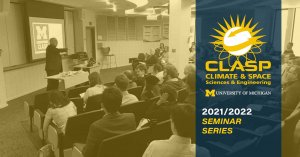Presented By: Climate and Space Sciences and Engineering
CLASP Seminar Series: Prof. Lee Murray of the University of Rochester

Prof. Lee Murray of the University of Rochester department of Earth & Environmental Sciences will give a lecture as part of the CLASP Seminar Series. Please join us!
Prof. Murray's presentation is titled "Factors controlling variability in the oxidative capacity of the atmosphere" and will take place on Thursday, October 7 at 3:30 p.m. EDT.
This seminar will be in person at the Climate and Space Research Building Auditorium, Room 2246.
The seminar may also be viewed via Zoom.
Please contact lhopkins@umich to request zoom access.
ABSTRACT:
Hydroxyl radical (OH) is a keystone species in the atmosphere, determining the removal rate of many trace gases of important to climate, composition and human and ecosystem health. Understanding how and why OH changes in space and time is therefore critical for predicting future changes in the self-cleaning capability of the atmosphere. Here, I present a series of projects aimed at characterizing global OH variability. First, we will explore why global atmospheric chemistry models differ so strongly in their OH abundances and forecasts even when driven by identical anthropogenic precursor emissions. Second, we will explore the possibility of a space-based proxy for variability in local OH columns. Lastly, we will use 4-D variational inverse modeling of methyl chloroform and 14CO observations in order to explore how and why global OH has changed over the past two decades.
Prof. Murray's presentation is titled "Factors controlling variability in the oxidative capacity of the atmosphere" and will take place on Thursday, October 7 at 3:30 p.m. EDT.
This seminar will be in person at the Climate and Space Research Building Auditorium, Room 2246.
The seminar may also be viewed via Zoom.
Please contact lhopkins@umich to request zoom access.
ABSTRACT:
Hydroxyl radical (OH) is a keystone species in the atmosphere, determining the removal rate of many trace gases of important to climate, composition and human and ecosystem health. Understanding how and why OH changes in space and time is therefore critical for predicting future changes in the self-cleaning capability of the atmosphere. Here, I present a series of projects aimed at characterizing global OH variability. First, we will explore why global atmospheric chemistry models differ so strongly in their OH abundances and forecasts even when driven by identical anthropogenic precursor emissions. Second, we will explore the possibility of a space-based proxy for variability in local OH columns. Lastly, we will use 4-D variational inverse modeling of methyl chloroform and 14CO observations in order to explore how and why global OH has changed over the past two decades.